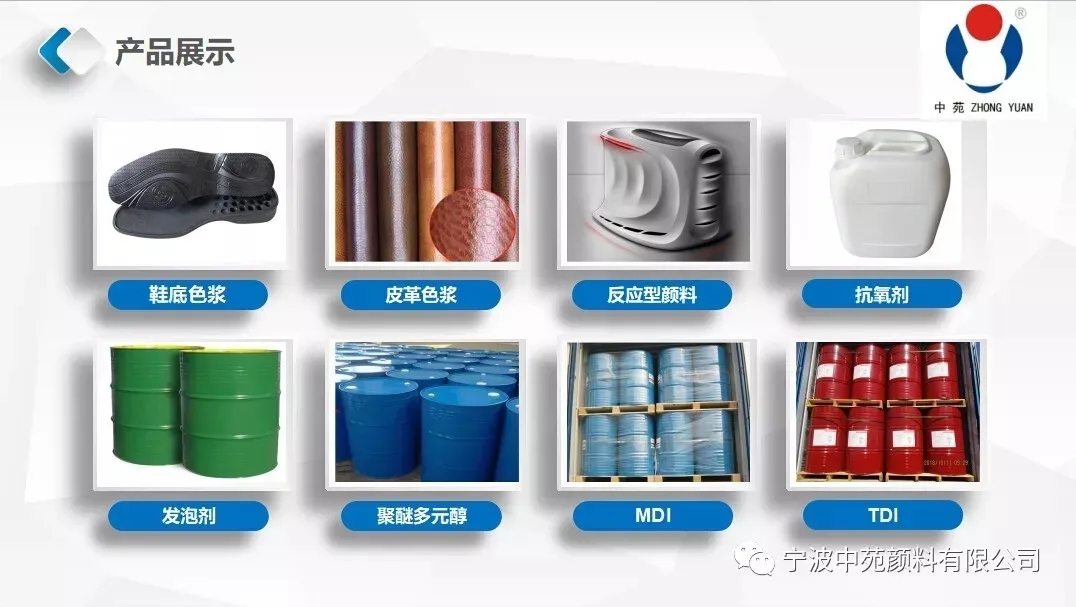
As the main assistant of polyurethane foam, color paste is widely used in all kinds of polyurethane materials. As a professional polyurethane color paste manufacturer in East China, the color paste produced by our factory has the characteristics of high color concentration, good fluidity, large amount of addition does not affect foaming, bright color, strong weather resistance, etc

Abstract: the advantages of rigid polyurethane foam and its application in real life work are described. The foaming process and molding method of rigid polyurethane foam are discussed, and the factors affecting the rigid polyurethane foam in foaming molding are analyzed in depth for reference.
1 General
In recent decades, the output of rigid polyurethane foam has been increasing rapidly in various fields of production and life. There are a lot of gas and liquid to be transported, stored and transported under the condition of heat preservation and cold preservation. For the insulation and cold preservation of these containers, equipment and pipelines, the traditional insulation and cold preservation materials, such as asbestos, slag cotton, perlite, sawdust, asphalt, glass fiber, etc., have many disadvantages. The construction procedures of these insulation materials are complex and inconvenient to operate, and some of them are harmful to the health of construction personnel. In addition, these thermal insulation materials have high thermal conductivity, poor thermal insulation effect, serious energy loss and short service life. In contrast, polyurethane rigid foam has the lowest thermal conductivity and can well discard the shortcomings of traditional thermal insulation materials, especially in terms of thermal insulation properties of materials. It is mainly used in construction and central heating industry, followed by refrigeration equipment such as refrigerators and freezers, as well as thermal insulation materials for transportation industry.
With the gradual maturation of rigid polyurethane foam production, the expansion of market supply, the deepening of research work, the development of new varieties, new technology, and the improvement of new equipment, the rigid polyurethane foam has been developed in an all-round way. Higher requirements for the preparation technology of rigid polyurethane foam products are put forward. Large scale foaming equipment is widely used for large-scale, continuous, automation and serialization to increase labour productivity, reduce cost and reduce raw material consumption. Computer controlled material parameters such as temperature, flow rate and flow rate are used to adjust and produce better polyurethane foam.
2 the advantages of rigid polyurethane foam
1) Good heat insulation effect. Using polyurethane rigid foam and polyisocyanurate rigid foam, not only the insulation layer is thin and light, but also the insulation effect is excellent.
2) Polyurethane rigid foam and polyisocyanurate rigid foam have very high closure rate, and can produce dense outer layer, which is not easy to permeate water, and has good waterproof effect.
3) Good thermal stability and wide working temperature range. The new polyurethane rigid foam and polyisocyanurate rigid foam insulation layer can work for a long time at 150 ℃, and the service life can be up to 25 years.
4) Good chemical resistance, not only heat preservation, but also good anticorrosion function.
5) Large scale mechanized production can be carried out in the factory, with high efficiency and good quality; the construction is simple and convenient, without damage to the health of construction personnel, safe and reliable.
3 rigid polyurethane foaming process and molding
Rigid polyurethane foam is divided into three types: prepolymer method, semi prepolymer method and one-step method.
1) Prepolymer method: usually, the same parts of polyether and isocyanate are mixed to form low molecular polymer prepolymer, and then water and prepolymer are stirred to form urea group to form high polymer. Due to the formation of carbon dioxide in the reaction, the chain grows and foams to form foam plastics.
2) semi prepolymer prepolymer: it is a mixture of a part of polyether and an excess isocyanate to form a low molecular weight polymer with a certain viscosity, which can form a hard or semi rigid foam after mixing the excess part of polyether with water, catalyst and surfactant.
3) one step method: the polyether, isocyanate and other components are mixed together to make foamed plastics. The one-step manufacturing process is simple and easy to operate. It can be used directly without processing. It can be carried out at room temperature. The products with good miscibility of raw materials and foaming performance are excellent.
The foaming process of rigid polyurethane foam usually consists of polyether or polyol, isocyanate, water, catalyst, surfactant and so on, and is mixed into a liquid raw material with a certain viscosity. After mixing at high speed, the reaction is carried out by mixing the metering pump in a mixing chamber at a high speed, and then sprayed into the mold. Polyurethane foam is formed after curing at fixed temperature. Nowadays, in industrial manufacturing, one-step process is often used to produce different types of prepolymers.
The simplest foaming method for rigid polyurethane foam is the manual foaming method. The raw materials are placed in a container in proportion to the speed, stirring and mixing evenly, injected into the space filled with foam plastics, and the polyurethane foam is formed after the chemical reaction is finished. The raw material utilization rate is low, and is suitable for scientific research and temporary construction in the laboratory. However, mechanical foaming is used in large-scale production, including continuous block foaming, pouring foaming, spraying foaming and other processes. The most common forming methods are pouring foaming, spraying foaming and continuous forming foaming. The properties of foams prepared by different foaming processes are also very different, and their shapes and appearances are also different.
The influence of rigid polyurethane foam forming
1) Raw materials: polyether and polyester are used as foaming components. The different proportion of polyether polyols and isocyanates can produce soft foam, semi rigid foam and rigid foam. The temperature of raw material directly affects the accuracy of metering ratio and the viscosity of material. Once the viscosity changes, the output accuracy of the metering pump changes, which seriously affects the quality of products. The components of polyether polyols are too large, the foamed plastics are soft, and the size stability is poor at high temperature; the isocyanate components are high, and the foams are hard and brittle.
2) temperature: during the foaming process, the temperature of the material and the environment directly affects the quality of the foam plastic products. However, long-term storage and temperature change are also unfavorable to isocyanate. The presence of dimer in isocyanate makes the change of isocyanate turbid and interferes with normal reaction. In production, the temperature is low, the foaming reaction is slow, the foam curing time is long, the temperature is high, the foaming reaction is fast, and the foam curing time is short.
3) Injection temperature, speed and pressure: before injection molding, high-pressure circulation shall be carried out, so that the material temperature will rise due to high-pressure movement, so the injection temperature is different from the storage temperature of the material. It depends on the cycle time and pressure, and the injection speed has a great influence on the mixing of raw materials. Good quality of foam products can be obtained by fast injection and high stamping speed.
4) mold temperature is the key factor of foaming molding, which can directly affect the foam, white drawing, non sticking and curing speed of foam, so it must be strictly controlled. Foaming molding is a chemical reaction exothermic process, the heat released to make the foaming agent vaporized, squeezing and extruding in the cavity filled with polyurethane, forming a bubble containing irregular bubbles. Mold temperature is an important process parameter, which not only affects the rate of reaction heat removal, but also affects the molding time, and has adverse effects on density, surface thickness and dimensional stability. During the foaming process, the foaming agent reacts with exothermic, forming the polymer in the filling cavity, which pushes, rolls and climbs to contact with the mold surface, and the bubble breaks and collapses to form a dense layer. If the mold temperature is high, it will form a very thin surface layer, which can not meet the color requirements, and the surface of the parts is prone to produce defects; if the temperature is low, the foaming rate is small, and the crust is too thick, which will reduce the heat conductivity.
5) curing time: when foam plastics are solidified and placed at a certain temperature, the aim is to make the foaming reaction complete and obtain good products. When injecting into the mould, the foaming material and mould should be heated and stored in a higher temperature environment after the foaming reaction. The higher the temperature, the shorter the curing time. The temperature is low, the curing time is long, and the curing is not enough. The curing time and temperature are different for different raw materials and parts.
6) Mixing: the mixing efficiency is a key factor in foaming. According to the characteristics of raw materials, the metering proportion and material temperature of foaming equipment are adjusted to achieve the purpose of full mixing. The mixture is uniform, and the foams are thin and even. The mixture is not good, the foams are coarse and uneven, and even the chemical reaction is not sufficient in the local area, which greatly affects the quality of the products.
7) During the foaming process, the reaction of polyether and isocyanate will produce carbon dioxide gas, and the expansion of polymer will produce a certain internal pressure. The mold restricts the development of foam shape. It should have enough strength and smoothness of inner surface to ensure that the foam is completely filled and will not cause foam cracking and hollow in the later foaming stage, so that the foam will be distributed evenly and densely in the mold. In addition, the injection port and exhaust port should be set up in a reasonable position to avoid the occurrence of local blisters and shrinkage.
5 Conclusion
In different industries, rigid polyurethane foam industry has been developing rapidly. For rigid polyurethane foam, the quality requirements are higher and higher. Therefore, for different raw materials, by changing the formula, improving the accuracy of foaming equipment and foaming molding process, we can prepare various rigid polyurethane foam products with different density, different properties and different applications.
![]()
We respect originality. The copyright of the materials with beautiful pictures belongs to the original author. Some articles cannot be contacted with the original author due to various reasons. If copyright issues are involved, please contact us and deal with them immediately.

Address: Longzhen Avenue, Longshan Industrial Zone, Cixi, Ningbo
Marketing Center: 1308, Yaojiang Xindu, Hongtang street, Jiangbei, Ningbo
Tel: +860574-86501282-0
83096225 83096226
Fax: +860574-86501283
Web:http://zy-pigment.en.alibaba.com/